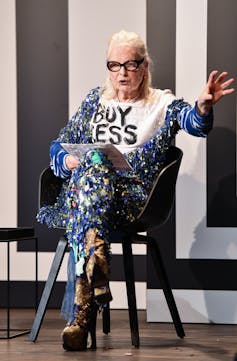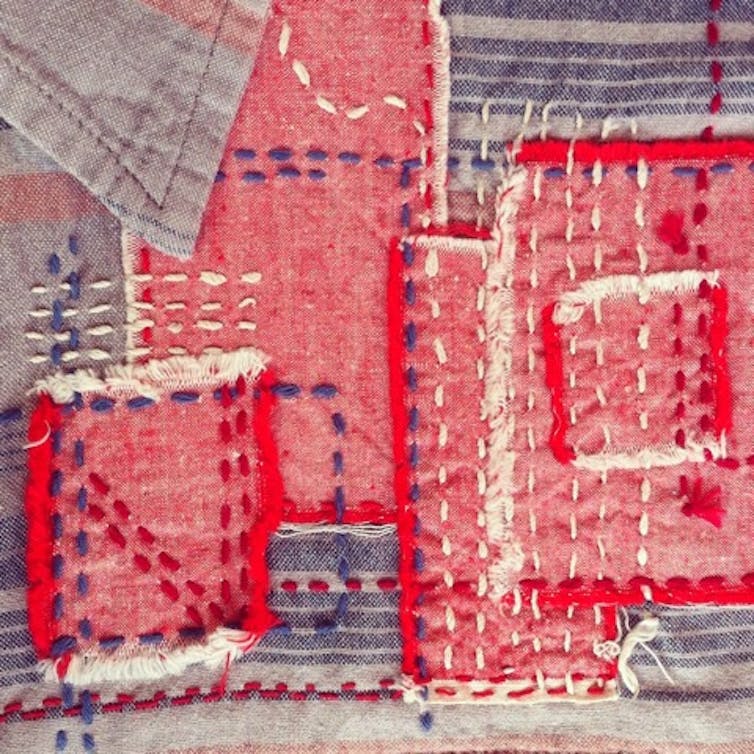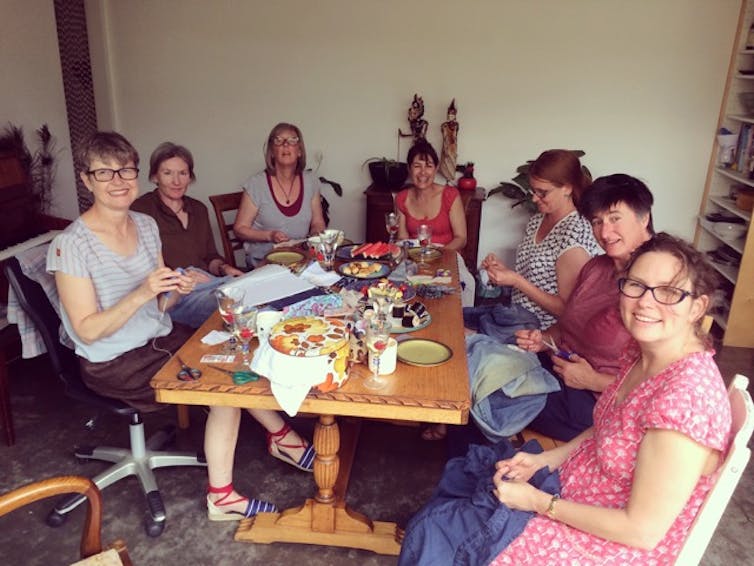punk's not dead, just patching itself up
- Written by Emily Brayshaw, Lecturer, Fashion and Design History, Theory, and Thinking, University of Technology Sydney
Visible mending is a quiet, global protest movement that’s happening at a grass-roots level, challenging the way we consume clothing. “We don’t need to throw our clothes away, and we’re wearing our mends as a badge of honour,” says Jane Milburn, a visible mender and author .
Many of us may donate our used clothes when we’ve finished with them, but the reality is that Australia doesn’t have the capacity to recycle all its old clothing, which generates millions of tonnes of waste annually. Many of our clothes are made of fabrics dyed with toxic chemicals and blended with synthetic polymer fibres, meaning they poison our planet at every stage in their life cycle. Says Milburn:
Mending and repurposing clothes is also a wonderful way to extend the life of garments that hold special emotional connections for us. You get moth [holes], you get rips, and instead of just throwing them away I mend them, which makes them individual. They are statements of resourcefulness, care and sustainability.
 Vivienne Westwood in 2017.
Jens Kalaene/DPA
Vivienne Westwood in 2017.
Jens Kalaene/DPA
Historically, visible mending was a sign of poverty – if you had to patch and repair your clothing, then you couldn’t afford to buy new garments or fabrics. But since the mid-1970s, many have embraced the aesthetic of distressed clothing, firstly via the punk styles created by Vivienne Westwood and later via grunge in the 1990s – helped by industrial techniques for stonewashing denim.
In the punk and grunge movements, ripped threads were loud sartorial protests against society and a lack of opportunities for young people. Today, buying cheap new clothes that are ripped, stained and have frayed seams is commonplace among younger consumers of fashion.
Read more: For a true war on waste, the fashion industry must spend more on research
The visible mending movement is also a response to distressed fast fashion. “Do it yourself, but don’t buy stuff that’s already ripped,” says Milburn. She describes the trend of buying new, distressed clothing as, “an obscene statement of our abundance and excess”.
Part of the attraction of visible mending is that Sashiko, a form of Japanese folk embroidery that is the main technique used by the movement, is simple to learn, says Melbourne-based visible mender Gaye Naismith.
Sashiko embroidery uses running stitch, which is the universal stitch: you can find it in every culture and anyone can do it. It uses Sashiko embroidery thread, which is not stranded like English embroidery thread; rather it’s a bit more like butcher’s string but a little thicker.
The thread, she says, was traditionally indigo and cream but now comes in lots of colours. “It’s rough and ready, but you can make something really pretty from it.”
 An exmaple of Sashiko embroidery.
Gaye Naismith
An exmaple of Sashiko embroidery.
Gaye Naismith
Visible mending also aims to reconnect people with vanishing life skills that were once ubiquitous. Darning, for instance, was once considered a vital skill to keep knitted and woven clothing wearable and stop further damage. It consists of anchoring yarn in the fabric on the edge of the hole, carrying it across the gap and then anchoring it on the other side, usually with a running stitch or two, until threads criss-cross the hole.
Darning holes in a garment with thread in contrasting shades can create beautiful patterns and pops of colour, especially in cardigans and socks. Visible menders such as Naismith hold workshops for people to re-learn and refine techniques such as this.
 Darning can create patterns in its own right.
Gaye Naismith
Darning can create patterns in its own right.
Gaye Naismith
Patching your clothes with meaningful textiles also allows you to wear your memories, says Naismith, who runs visible mending parties where people bring their sewing projects, and share cake and ideas. The groups can also help to combat loneliness and be a form of self-care. “Most people find it very relaxing and satisfying because sewing by hand forces you to slow things down,” says Naismith.
The visible mending community is thriving online, with local social networking groups such as “Friends of the Up-Cycled Cloth Collective, Australia and New Zealand” and international ones such as “A Mend and Made Do Life”, which has more than 14,800 members.
 A visible mending party.
Gaye Naismith
A visible mending party.
Gaye Naismith
There are countless Pinterest, Instagram and visible mending blogs that can provide aesthetic inspiration for your projects, and more than a thousand tutorials online that demonstrate repairing techniques.
At the conclusion of her 2013 London fashion show Westwood, the grand doyenne of punk, made an impassioned plea to consumers to protest the excesses of her industry: “Buy less. Choose well. Make it last.”
Her call has inspired visible menders, who are once again placing our clothing at the centre of a protest movement. Visible mending, says Naismith, is “a bit punk”. “People are doing it as a reaction to the whole fashion industry’s excesses of production.” Forty years later, it seems that punk’s not dead; it’s just patching itself up.
Authors: Emily Brayshaw, Lecturer, Fashion and Design History, Theory, and Thinking, University of Technology Sydney
Read more http://theconversation.com/visible-mending-punks-not-dead-just-patching-itself-up-91226



